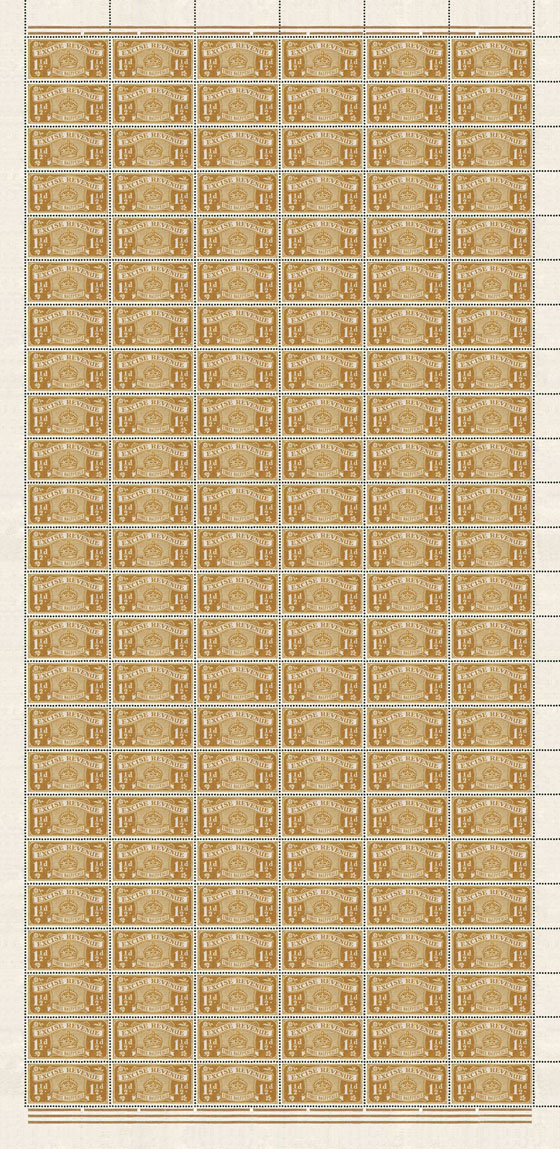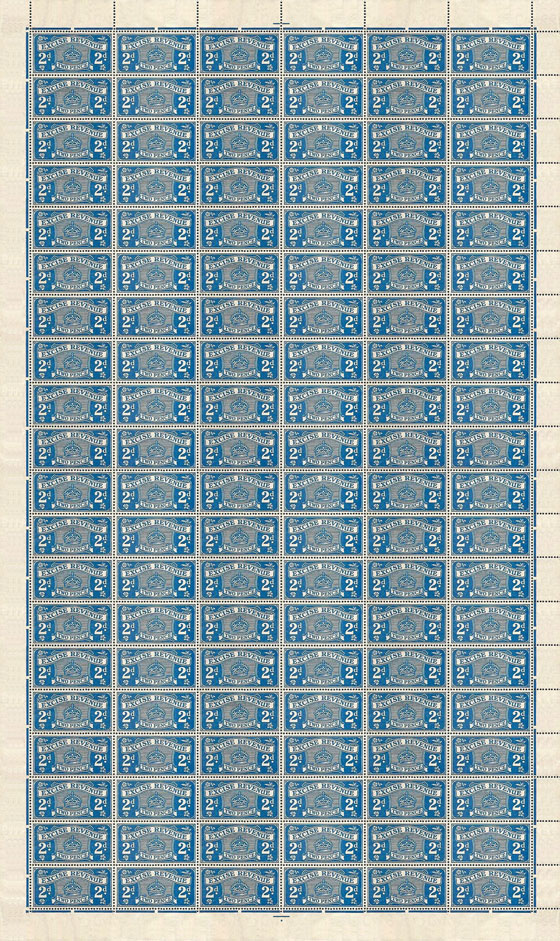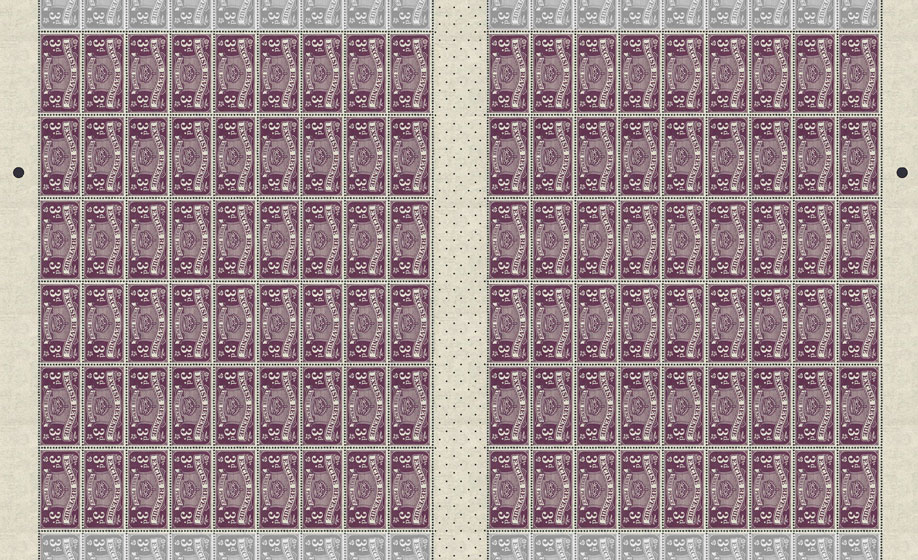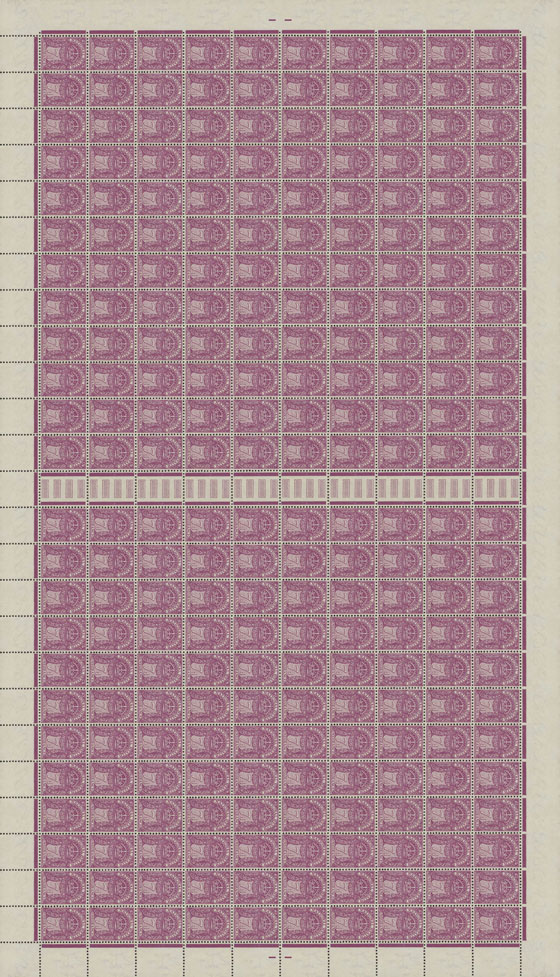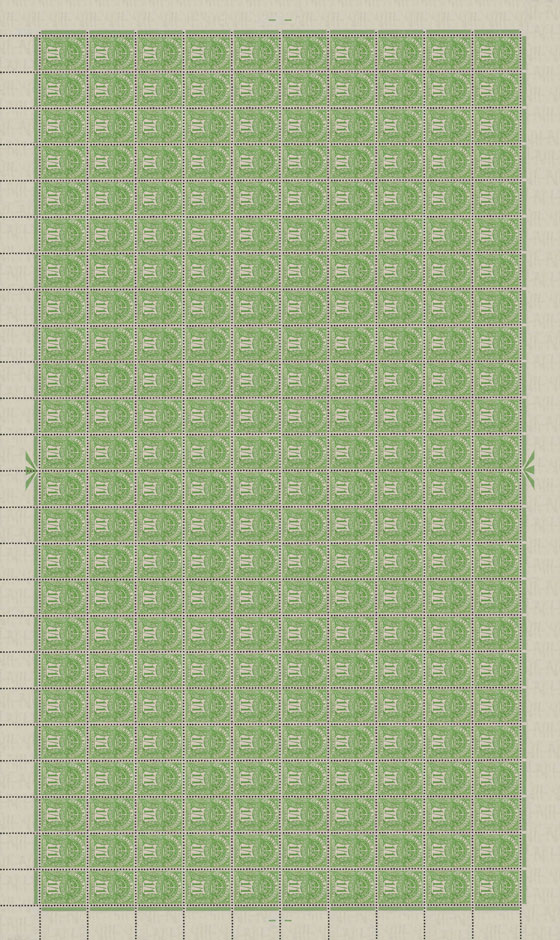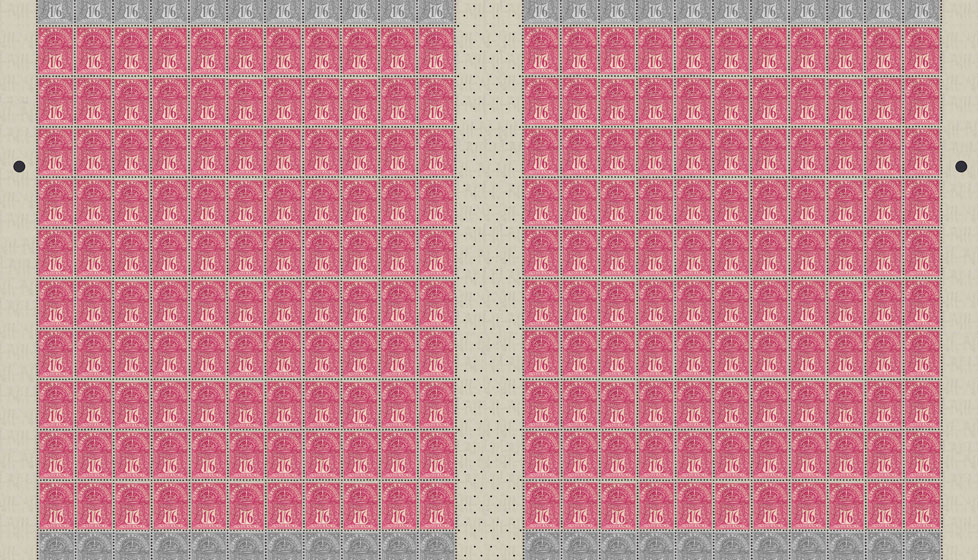
Information about revenue stamps issued in rolls is limited. This page is based on some album pages from the late Lt-Col. J. B. M. Stanton, which were photocopied before being broken up, and from information in Post Office records, Royal Mint records, and Acts of Parliament.
Excise Revenue
The Finance (New Duties) Act 1916, effective 15 May 1916, established a excise duty on “payments for admission to any entertainment” as a temporary war tax (it was finally repealed in 1960). The duty was paid by an adhesive stamp stuck on an entrance ticket. Stamps were usually cancelled by tearing the ticket & stamp in half, but some venues were reusing the stamp halves and so check letters were introduced in 1925.

Watermarks: Simple Cypher, Block Cypher, Block SO, Script SO
The stamps were printed by Harrison and Sons on the same Simple Cypher paper they were using for postage stamps. When the printing contract passed to Waterlow and Sons on 1 Jan 1924, the paper changed to Block Cypher and, when Waterlow’s contract expired on 31 Dec 1933, printing passed to HM Stationery Office using a Block SO paper. Circa 1950, the watermark changed to a Script SO, but no rolls were made with this paper. The duty was initially based on a scale as follows, with many modifications in the following years.
| Payment | Duty |
|---|---|
| up to 2d | ½d |
| over 2d to 6d | 1d |
| over 6d to 2/6 | 2d |
| over 2/6 to 5/- | 3d |
| over 5/- to 7/6 | 6d |
| over 7/6 to 12/6 | 1/- |
| over 12/6 | 1/- + 1/- for every further 10/- |
1916 Harrison and Sons
The four most used values of Excise Revenue stamps were issued in rolls in 1916, with a 1½d roll added in 1919 after the Finance Act 1919, effective 1 Oct 1919, introduced a 1½d duty on 4½d tickets (for a total of sixpence). The first printings were in sheets of 144 (24 rows of six). A new layout was adopted in 1921, with sheets of 120 (20 rows of six) for all values up to the one shilling. Rolls were made from strips of six stamps.
| — | 2d | 480 | £4 | Left Side | Buff | 6 |
| — | 3d | 480 | £6 | Left Side | Buff | 6 |
| — | 6d | 480 | £12 | Left Side | Buff | 6 |
| — | 1/- | 480 | £24 | Left Side | Buff | 6 |
| — | 1½d | 480 | £3 | Left Side | Buff | 6 |
The leaders below were pasted onto a sheet in Stanton’s collection. The sheet was mounted to a page with a description: Excise revenue stamps were also issued in coils. Specimen sheet of proofs. At some time since the albums were broken up, the leaders were roughly taken off the sheet, causing some thinning, and random excise revenue stamps were attached (now removed).
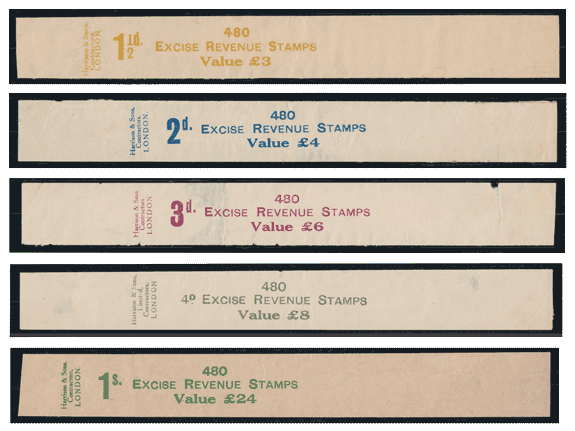
The format of the printer’s imprint suggests a Harrison printing up to 1920 (the company became Limited in 1920) and the 1½d issued in Oct 1919 narrows the window. Thus, these are likely 1919 to 1920, with the 4d leader 1920 to 1924. The Specimen sheet of proofs also had spaces for 6d, 9d, and 1/6 rolls, and stated that the leaders for these denominations were printed in black, with the rate and value inserted in manuscript:
1924 Waterlow and Sons
The printing contract passed from Harrison to Waterlow on 1 Jan 1924, partially on the expectation that Waterlow was to print rolls by the continuous letterpress process established at Somerset House. There were concerns expressed in November 1923 about the unprinted central gutter and it was decided to “cross perforate” the gutter with a pattern of holes to avoid any misuse. Perforation combs were made for postage, insurance, and excise revenue stamps.
The contract specified that rolls were to be sealed with printed paper bands in approximately the same colour as the stamps. Rolls of 1½d, 2d, 3d, 4d, 6d, 9d, 1/-, and 1/6 stamps could be made from sheets (joined every 6 stamps) or printed continuously. Sheet stamps (for joined rolls) were to be printed on Wharfedale printing machines. Continuous printing required a new form of printing plate with two panes of 54 (6 rows of 9) separated by a cross perforated gutter, for use on Grover’s reel printing machines. The watermark for continuous rolls could be at right angles to the vertical direction of the stamp (i.e. sideways). Plate layouts were as follows.
Click the images to enlarge.
Although the Finance Act 1917, effective 1 Oct 1917, introduced new duties of 4d, 9d, and 1/6, stamps of these values were initially only available in sheets. They were not issued in rolls until 1927, bringing the total number of rolls to eight.
| — | 4d | 480 | £8 | Left Side | Buff | 6 |
| — | 9d | 480 | £18 | Left Side | Buff | 6 |
| — | 1/6 | 480 | £36 | Left Side | Buff | 6 |
The Finance (No. 2) Act 1931, effective 9 Nov 1931, expanded the scale of duties by adding a penny duty for each extra sixpence, creating six new stamps: 2½d, 5d, 7d, 8d, 10d, and 11d. All six were available both as sheets of 120 and as rolls of 480, bringing the total number of rolls to 14.
| — | 2½d | 480 | £5 | Left Side | Buff | 6 |
| — | 5d | 480 | £10 | Left Side | Buff | 6 |
| — | 7d | 480 | £14 | Left Side | Buff | 6 |
| — | 8d | 480 | £16 | Left Side | Buff | 6 |
| — | 10d | 480 | £20 | Left Side | Buff | 6 |
| — | 11d | 480 | £22 | Left Side | Buff | 6 |
1934 HMSO
Waterlow’s contract expired on 31 Dec 1933 and printing of excise revenue stamps was transferred to HM Stationery Office. HMSO continued to use flat printing plates on Wharfedale printing machines, printing the stamps in sheets on a Block SO paper. There were no continuous printings.
Rolls of 9d, 11d, and 1/6 stamps were no longer offered from 1936 (reducing the number of rolls to 11), then 8d and 10d rolls were dropped from 1937 (reducing the number to 9). No excise revenue stamps were offered in rolls after WWII, stamps were only available as sheets. Circa 1950, the watermark changed to a Script SO, but no rolls were made with this paper. Entertainments duty was finally repealed on 9 Apr 1960.
National Health Insurance
The National Insurance Act 1911 Part I, effective 15 July 1912, established compulsory health insurance for some 13 million workers. Insurance was paid by contributions from the employee and employer, and subsidised by the government. The employee+employer contributions were paid by stamps affixed weekly to contribution cards, although arrangements could be made by larger employers to affix high-value stamps quarterly, half-yearly, or annually. The amount of the weekly contribution depended on the Class of the employee, initially as in the simplified table below, with lower rates in Ireland. There were variations on the rates for juveniles, low-earners, mariners, and outworkers: A(J), A(L), A(M), A(O), etc.
| Class | Description | GB | Ireland |
|---|---|---|---|
| A | Man, employed | 7d | 5½d |
| B | Man, army | 3d | 3d |
| C | Man, voluntary under 45 | 7d | 5½d |
| D | Man, voluntary 45 and up | 9d-1/5 | 7d-1/2 |
| E | Woman, employed | 6d | 4½d |
| F | Woman, voluntary under 45 | 6d | 4½d |
| G | Woman, voluntary 45 and up | 8d-1/3 | 6d-1/- |
| H | Woman, married | 3d | 1½d |
In December 1912, the most used values of National Health Insurance stamps, Classes A and E, were issued in rolls (suitable for use with affixing machines). These were in Ireland: women 4½d, men 5½d; and in England, Wales, and Scotland: women 6d, men 7d. The National Health Insurance Act 1920, effective 5 July 1920, increased the contributions to 7d, 8d, 9d, and 10d respectively.

Watermarks: Multiple Cypher, Simple NHI, Block NHI, sideways
1912 Waterlow Contract
The printing contract was awarded to Waterlow Brothers and Layton Ltd on 1 May 1912 (WB&L merged into Waterlow and Sons in 1920). There was a delay obtaining the “Simple NHI” watermarked paper, so Somerset House made preliminary printings of some values on Multiple Cypher paper. (Somerset House continued to print certain high value insurance stamps until 1934.) Printings were in sheets of 240 consisting of two panes of 120 (12 rows of 10) separated by a horizontal row of bars. Although the stamps were in a vertical format, they were printed sideways in a horizontal format, matching the layout of the Unemployment Insurance sheets. Rolls were made from strips of 10 stamps, for both top-end and bottom-end delivery.

| Rolls | Class E Woman | Class A Man | ||||
|---|---|---|---|---|---|---|
| Dec 1912 † | 4½d | 480 | £9 | 5½d | 480 | £11 |
| Dec 1912 ‡ | 6d | 480 | £12 | 7d | 480 | £14 |

| Rolls | Class E Woman | Class A Man | ||||
|---|---|---|---|---|---|---|
| July 1920 † | 7d | 480 | £14 | 8d | 480 | £16 |
| July 1920 ‡ | 9d | 480 | £18 | 10d | 480 | £20 |
† in Ireland
‡ in England, Wales and Scotland
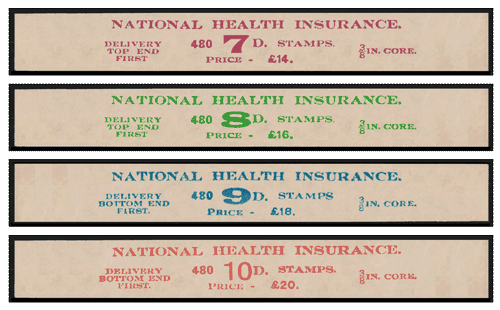
Reconstructions from Stanton’s album page.
Note “Bottom End” instead of the usual “Lower End”.
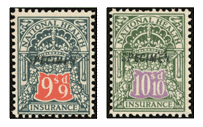
| Rolls | Class E Woman | Class A Man | ||||
|---|---|---|---|---|---|---|
| July 1920 | 9/9 | 480 | £234 | 10/10 | 480 | £260 |
9/9d and 10/10d stamps were for quarterly payments, 13 weeks at 9d, or 13 weeks at 10d. There are no images of the leaders, but they are described as printed in green. These rolls were not sold in post offices.
1924 Waterlow Contract
The postage stamp contract passed from Harrison to Waterlow on 1 Jan 1924. Waterlow had been printing insurance stamps since 1912 but the new contract had several effects on insurance stamps: for economy in the use of paper, all printing plates had the horizontal row of bars removed, joining the two panes of 120 into a single pane of 240; an arrow was added in each side margin, marking the division point into half-sheets; and a new paper supplier was selected causing a watermark change from Simple NHI to Block NHI.
The contract specified that rolls were to be sealed with buff coloured paper bands printed in approximately the same colour as the stamps. Rolls of 7d, 8d, 9d, and 10d stamps could be made from sheets (joined every 10 stamps) or printed continuously; rolls of 9/9 and 10/10 stamps were to be made from sheets. Sheet stamps (for joined rolls) were to be printed on Wharfedale printing machines. Continuous printing required a new form of printing plate with two panes of 110 (10 rows of 11) separated by a cross perforated gutter, for use on Grover’s reel printing machines. Plate layouts were as follows.
Click the images to enlarge.
1926 Health & Pensions
National Health Insurance stamps were replaced by Health & Pensions stamps in 1926. A combined program for health insurance and old-age pensions was establish by the Widows’, Orphans’ and Old Age Contributory Pensions Act 1925, effective 4 Jan 1926. At introduction, contributions under both health and unemployment insurance were lowered, bringing the ordinary weekly rate for combined contributions to 1/1 for women (health 8½d, pension 4½d) and 1/6 for men (health 9d, pension 9d). Section 43 of the Act provided for an increase in the contributions for pensions during the decennial periods commencing 1 Jan 1936, 1 Jan 1946, and 1 Jan 1956, of 1d for women and 2d for men, bringing the combined contributions for 1936 to 1/2 and 1/8.
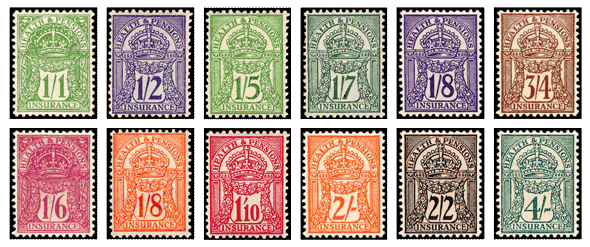
Women (top row) and men (bottom row): 1926-1946.
Printed by Waterlow, then HMSO from 1934.
The Old Age and Widows’ Pensions Act 1940, effective 1 July 1940, reduced the retirement age for women from 65 to 60 and increased the contributions for pensions by 3d for women and 2d for men, bringing the combined contributions to 1/5 and 1/10. The Contributory Pensions and Workmen’s Compensation Act 1941, effective 5 Jan 1942, increased the contributions for health by 2d, bringing the combined contributions to 1/7 for women (health 10½d, pension 8½d) and 2/- for men (health 11d, pension 1/1). The decennial increase from the 1925 Act was applied 1 Jan 1946 bringing contributions to 1/8 and 2/2.
| Rolls | Class E Woman | Class A Man | ||||
|---|---|---|---|---|---|---|
| Jan 1926 † | 11d | 480 | £22 | 1/4 | 480 | £32 |
| Jan 1926 ‡ | 1/1 | 480 | £26 | 1/6 | 480 | £36 |
| Jan 1936 | 1/2 | 480 | £28 | 1/8 | 480 | £40 |
| July 1940 | 1/5 | 480 | £34 | 1/10 | 480 | £44 |
| Jan 1942 | 1/7 | 480 | £38 | 2/- | 480 | £48 |
| Jan 1946 | 1/8 | 480 | £40 | 2/2 | 480 | £52 |
| Sept 1946 | 3/4 | 480 | £80 | 4/- | 480 | £96 |
† in Northern Ireland (until 6 July 1930)
‡ in Great Britain (and NI from 7 July 1930)
1934 HMSO
Waterlow’s contract expired on 31 Dec 1933 and printing of insurance stamps was transferred to HM Stationery Office. HMSO continued to use flat printing plates on Wharfedale printing machines for insurance stamps where the numbers required were relatively small, but the higher volume stamps were printed on Victory-Kidder rotary printing machines. Ten curved steel printing plates (each with 24 stamps) were mounted on a cylinder. Stamps were printed in sheets of 240 from the reel, perforated while the paper was stationary, then guillotined to size.
Health & Pensions stamps were replaced by National Insurance stamps when the National Insurance Act 1946 came into effect on 5 July 1948. However, in transition to the new scheme, the pension provisions of the Act were brought into effect on 30 Sept 1946 with substantially higher pensions supported by a significant increase in contributions to 3/4 and 4/-.
Unemployment Insurance
The National Insurance Act 1911 Part II, effective 15 July 1912, established unemployment insurance for some 2¼ million workers, primarily those engaged in manual labour. As with health insurance, contributions were paid by stamps affixed to contribution cards. The amount of the weekly contribution depended on the number of days worked, initially as in the simplified table below.
| Workman | Rate |
|---|---|
| Man weekly | 5d |
| Man 2 days | 4d |
| Man 1 day | 2d |
| Boy | 2d |
In December 1912, the most used value of Unemployment Insurance stamps, a weekly contribution of 5d, was issued in rolls (suitable for use with affixing machines). The Unemployment Insurance Act 1920, effective 8 Nov 1920, increased the contributions to 6½d for women and 8d for men. The Unemployment Insurance (No. 2) Act 1921, effective 4 July 1921, increased them to 1/1 and 1/3, and then the Unemployed Workers’ Dependants (Temporary Provision) Act 1921, effective 7 Nov 1921, increased them to 1/3 and 1/7.
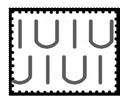
Watermark: Block UI
1912 Waterlow Contract
The printing contract was awarded to Waterlow Brothers and Layton Ltd on 1 May 1912 (WB&L merged into Waterlow and Sons in 1920). The stamps were the same size as National Health Insurance stamps, but in a horizontal format. Thus, the rolls were for sideways delivery instead of endways. Printings were in sheets of 240 consisting of two panes of 120 (12 rows of 10) separated by a horizontal row of bars. Rolls were made from strips of 10 stamps, for both left-side and right-side delivery.

| Rolls | Woman | Man | ||||
|---|---|---|---|---|---|---|
| Dec 1912 | 5d | 480 | £10 | 5d | 480 | £10 |
| Nov 1920 | 6½d | 480 | £13 | 8d | 480 | £16 |
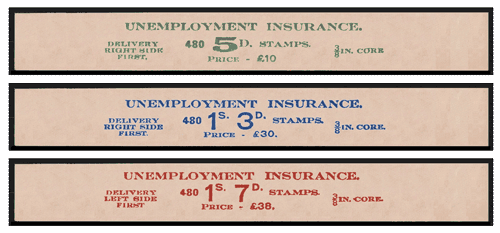
Reconstructions from Stanton’s album page.
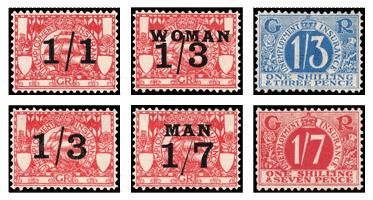
Women (top row) and men (bottom row): 1921-1922.
| Rolls | Woman | Man | ||||
|---|---|---|---|---|---|---|
| July 1921 | 1/1 | 480 | £26 | 1/3 | 480 | £30 |
| Nov 1921 | 1/3 | 480 | £30 | 1/7 | 480 | £38 |
| Apr 1922 | 1/3 | 480 | £30 | 1/7 | 480 | £38 |
1924 Waterlow Contract
The postage stamp contract passed from Harrison to Waterlow on 1 Jan 1924. Waterlow had been printing insurance stamps since 1912 but the new contract had several effects on insurance stamps: for economy in the use of paper, all printing plates had the horizontal row of bars removed, joining the two panes of 120 into a single pane of 240; and an arrow was added in each side margin, marking the division point into half-sheets.
The contract specified that rolls were to be sealed with pale blue coloured paper bands printed in approximately the same colour as the stamps. Rolls of 1/3 and 1/7 stamps could be made from sheets (joined every 10 stamps) or printed continuously. Sheet stamps (for joined rolls) were to be printed on Wharfedale printing machines. Continuous printing required a new form of printing plate with two panes of 110 (10 rows of 11) separated by a cross perforated gutter, for use on Grover’s reel printing machines. Plate layouts were as the insurance stamps above.
1926 Health & Pensions
To align with Health & Pensions (see above), the Unemployment Insurance Act 1925, effective 4 Jan 1926, lowered the unemployment insurance contributions to 1/1 for women and 1/3 for men. The National Economy Act 1931, effective 5 Oct 1931, raised them to 1/6 and 1/8, then the Unemployment Insurance (Reduction in the Weekly Rates of Contributions) Order 1936, effective 6 July 1936, reduced them to 1/4 and 1/6, and then the Unemployment Insurance Act 1940, effective 5 Aug 1940, returned them to 1/6 and 1/8, where they stayed until replaced by National Insurance stamps in 1948.
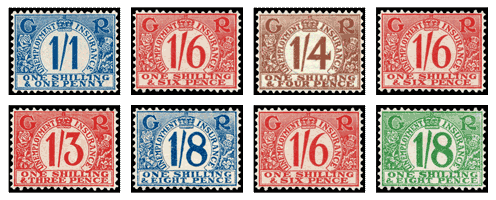
Women (top row) and men (bottom row): 1926-1940.
Printed by Waterlow, then HMSO from 1934.
| Rolls | Woman | Man | ||||
|---|---|---|---|---|---|---|
| Jan 1926 | 1/1 | 480 | £26 | 1/3 | 480 | £30 |
| Oct 1931 | 1/6 | 480 | £36 | 1/8 | 480 | £40 |
| July 1936 | 1/4 | 480 | £32 | 1/6 | 480 | £36 |
| Aug 1940 | 1/6 | 480 | £36 | 1/8 | 480 | £40 |
1934 HMSO
Waterlow’s contract expired on 31 Dec 1933 and printing of insurance stamps was transferred to HM Stationery Office. HMSO continued to use flat printing plates on Wharfedale printing machines for insurance stamps where the numbers required were relatively small, but the higher volume stamps were printed on Victory-Kidder rotary printing machines. Ten curved steel printing plates (each with 24 stamps) were mounted on a cylinder. Stamps were printed in sheets of 240 from the reel, perforated while the paper was stationary, then guillotined to size.
Unemployment Insurance stamps were replaced by National Insurance stamps in 1948.
National Insurance
Health & Pensions and Unemployment Insurance stamps were replaced by National Insurance stamps when the National Insurance Act 1946, the National Insurance (Industrial Injuries) Act 1946, and the National Health Service Act 1946 came into effect on 5 July 1948. The alphabetical classes of the previous system were replaced by numerical classes: Class 1 (employed), Class 2 (self-employed), and Class 3 (non-employed). Contributions were initially as in the table below. Special rates for Mercantile Marines were added in Dec 1950.
| Class | Man | Woman | Boy † | Girl † |
|---|---|---|---|---|
| Class 1 | 9/1 | 7/1 | 5/4 | 4/3 |
| Class 2 | 6/2 | 5/1 | 3/7 | 3/1 |
| Class 3 | 4/8 | 3/8 | 2/9 | 2/3 |
| Employed Abroad | 8/5 | 6/7 | 4/11 | 3/11 |
| Exempt | 4/6 | 3/6 | — | 2/1 |
| Abroad & Exempt | 3/10 | 3/- | — | 1/9 ‡ |
| Industrial Injuries | 8d | 6d | 5d | 4d |
† under 18
‡ no stamps for this rate
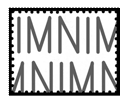
Watermark: Block MNI (Ministry of National Insurance)
Stamps for Class 1 contributions had the value in a rectangle, for Class 2 in an oval, and for Class 3 in a diamond. Stamps were issued in rolls for the two most used values: Class 1 Women and Class 1 Men. Rolls were made for both left-side and right-side delivery. After large-scale forgery of the first letterpress stamps in 1950, HMSO installed new machinery so that subsequent issues could be printed in photogravure, making forgery more difficult.

Women (top row) and men (bottom row): 1948-1957.
Printed by HM Stationery Office.
| Rolls | Class 1 Woman | Class 1 Man | ||||
|---|---|---|---|---|---|---|
| July 1948 | 7/1 | 480 | £170 | 9/1 | 480 | £218 |
| Oct 1951 | 7/5 | 480 | £178 | 9/5 | 480 | £226 |
| Oct 1952 | 8/5 | 480 | £202 | 10/9 | 480 | £258 |
| June 1955 | 10/5 | 480 | £250 | 12/9 | 480 | £306 |
| Sept 1957 | 11/1 | 480 | £266 | 13/7 | 480 | £326 |
| Feb 1958 | 14/3 | 480 | £342 | 17/6 | 480 | £420 |
| July 1958 | 14/9 | 480 | £354 | 18/2 | 480 | £436 |
| Apr 1961 | 15/2 | 480 | £364 | 18/2 | 480 | £436 |
| July 1961 | 16/0 | 480 | £384 | 19/2 | 480 | £460 |
| June 1963 | 18/0 | 480 | £432 | 21/4 | 480 | £512 |

Women (top row) and men (bottom row): 1958-1963.
Printed by HM Stationery Office.
Although Class 1 National Insurance stamps continued in use until April 1975 (Class 2, Class 3, and Share Fishermen until April 1993), none were offered in rolls after 1963.
Prescription Charges
Prescription charges were introduced in the National Health Service (Amendment) Act 1949, but were not implemented until March 1952, at a rate of one shilling per prescription form. In November 1956 the rules were changed so that the charge applied to each item prescribed. In March 1961 the charge was doubled to two shillings. Charges were abolished on 1 February 1965, then reintroduced on 10 June 1968 at the higher rate of 2/6, but with a wider range of exemptions.
Initially charges were paid in cash, but around 1960 stamp vending machines were installed in hospital dispensaries. The machines, made by Associated Automation (Hall Telephone Accessories became Associated Automation in 1956), dispensed rolls of 1,000 stamps which were printed by Harrison & Sons and had a script watermark of “Harrison & Sons, London”. Every fifth stamp bore a serial number starting with “005” and ending with “000” on the 1,000th stamp.
| — | 1/- | 1,000 | £50 | Lower End | Yellow | c |
| — | 2/- | 1,000 | £100 | Lower End | Yellow | c |
| — | 6d | 1,000 | £25 | Lower End | Yellow | c |
| — | 2/6 | 1,000 | £125 | Lower End | Yellow | c |

Although beyond the scope of this site, it’s interesting to take a quick look at the decimal rolls which replaced the £sd rolls, a 10p scarlet (1971), and this 5p green (1979) showing the same serial numbers as the 6d roll above.

